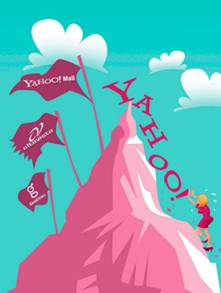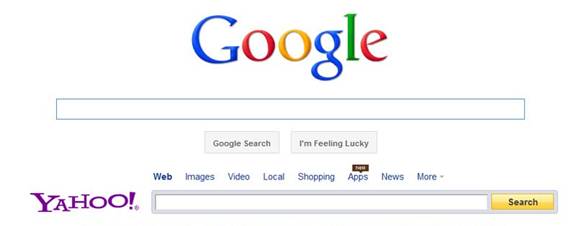Now largely irrelevant in a tech landscape
that they helped to shape, can Yahoo’s fortunes be turned around by a new CEO?

The
fight for Yahoo’s future
“David and Jerry’s Guide to the World Wide
Web”
That was the name David Filo and Jerry Yang
gave to the website they founded back in 1994, which would eventually become
Yahoo. For a good stretch in the late 1990s and early 2000s, the web portal was
king. Yahoo was an icon of the dot-com boom, and a milestone on the road of the
online age we currently travel.
At its zenith, Yahoo provided services such
as Geocities, AltaVista search, news aggregation and Yahoo Mail. Products such
as del.icio.us and Flickr were precursors to the link-swapping and
photo-sharing that we see today. At the turn of the millennium, it seemed like
Yahoo was the juggernaut that couldn’t be stopped. However, as most of the
younger internet-savvy users of today are unlikely to even remember Geocities
or AltaVista, that was clearly not the case.
With the benefit of hindsight, where Yahoo
went wrong was obvious. An internal memo, now known as the Peanut Butter
Manifesto, was leaked in 2006 during the early onset of the decline, which
scathingly criticized Yahoo for its lack of focus. Besides the stable of
products and services it had acquired, Yahoo also had its fingers in various
pies, some of which included job search, advertising, social media and music.
With resources and investment spread so thin, none of the products or services
Yahoo held could be given the attention needed to succeed.
To compound matters, a new bunch of
startups had sprung up with an eye on Yahoo’s traditional strongholds. Google
and its search engine outperformed Yahoo Search so thoroughly, that the latter
tried to acquire Google for up for US$3 Billion in 2002 before the former’s
public offering. Facebook ushered in a new way for people to live out their
digital lives, showing Yahoo Communities and the mobile lifestyle became
ubiquitous. The world Yahoo had helped create, had changed dramatically, and
they just couldn’t keep up.

Much of Yahoo’s success came during Jeff
Mallet’s tenure as President and COO, starting when Yahoo went public in 1996.
It is also not coincidental that the beginnings of its decline can be traced back
to his replacement, Terry Semel in 2001, who came on as Chairman and CEO.
Having made his name in Hollywood with Warner Brothers, Semel helped Yahoo
expand its holdings by brokering deals for a variety of dot-com companies. But
critically, he is also known for having passed up the opportunity to invest is
Larry Page’s and Sergei Brin’s little startup by the name of Google.
It can be argued that a company is defined
by their CEO. Take Steve Jobs at Apple, Bill Gates at Microsoft, and Mark
Zuckerberg at Facebook. You can see hints of the leader’s personalities in the
corporations. And if you believe that the choice of CEO says a lot for the type
of company that employs them, Yahoo didn’t look good.
Post-Semel, founder Jerry Yang came back in
2007 for a short stint, before eventually passing the CEO reins over to Carol
Bartz in 2009. Unable to reinvent the ailing site, she was famously dismissed
via phone call in late 2011. After which she emailed the entire Yahoo worldwide
staff to personally inform them of the company to issue a statement. The next
to assume the CEO title, Scott Thomson who was appointed in earlier 2012,
lasted just four months, having been fired after it was discovered that he had
lied about a degree on his resume.
Marissa Mayer is an archetype for the
Google employee. Graduating from Standford with a Bachelor’s in Symbolic
Systems and a Master’s in Computer Science, she also specialized in artificial
intelligence for both degrees. She was the 20th employee hired by Google, and
also their first female engineer.
Within a year of working on the web server
team, she branched out into the user-experience and human-interaction
departments. Soon she was advising on marketing and branding, along with
coordinating Google Doodles. In 2001 she was officially transferred from
engineer to Products, and was given the responsibility of user interaction lead
for Google.com.

The clean cut, minimalist look of the
search engine we all know and love today is thanks to Mayer’s work and
oversight. She modeled the look after a closed Swiss army knife. Simple and
unassuming, all the tools required for a situation can be found, only awaiting
activation from the user. There is no doubt that she had already made a lasting
impact on the tech landscape with the Google search homepage.
While making sure Google’s search engine
stayed ahead of the curve throughout her tenure, Mayer was also involved with a
host of other products. Her background in artificial intelligence was
instrumental in making Google products smarter and more adept. Google News,
Google Desktop Search, Gmail, iGoogle, Google Maps and many other products
benefitted from her involvement.
In 2002, Mayer was named the Vice President
for Local and Location services as well as becoming involved with the 12-man inner-circle
that made up the operating committee and top decision-makers inside Google.
However, in 2011 she was leapfrogged by
Jeff Huber for a promotion to the senior leadership team. At the same time
Larry Page took over as CEO of Google, and Mayer was dropped from his new
inner-circle. To compound matters further, her longtime boss Jonathan Rosenberg
also resigned from his post.